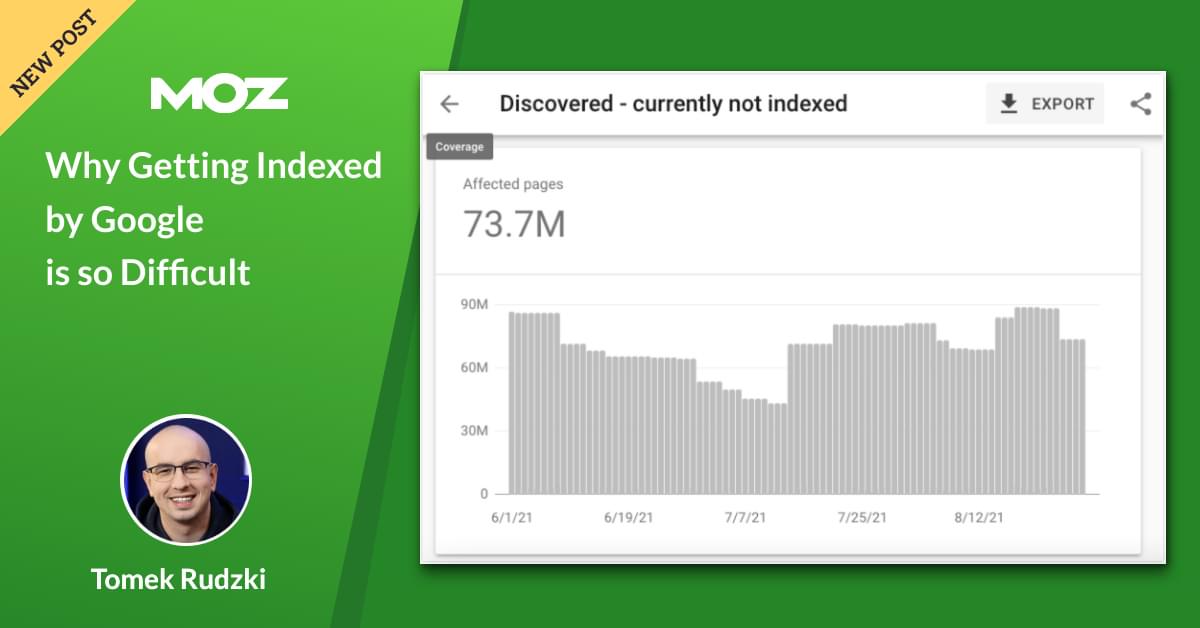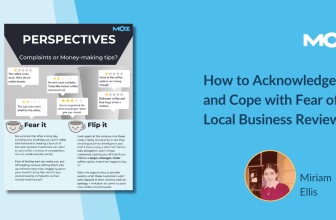Why Getting Listed by Google is so Tough

[ad_1]
The creator’s views are solely his or her personal (excluding the unlikely occasion of hypnosis) and should not at all times replicate the views of Moz.
Each web site depends on Google to some extent. It’s easy: your pages get listed by Google, which makes it attainable for folks to search out you. That’s the way in which issues ought to go.
Nevertheless, that’s not at all times the case. Many pages never get indexed by Google.
Should you work with an internet site, particularly a big one, you’ve in all probability seen that not each web page in your web site will get listed, and lots of pages look ahead to weeks earlier than Google picks them up.
Numerous elements contribute to this challenge, and lots of of them are the identical elements which are talked about with regard to rating — content material high quality and hyperlinks are two examples. Generally, these elements are additionally very advanced and technical. Trendy web sites that rely closely on new internet applied sciences have notoriously suffered from indexing issues in the past, and a few nonetheless do.
Many SEOs nonetheless imagine that it’s the very technical issues that forestall Google from indexing content material, however this can be a fable. Whereas it’s true that Google may not index your pages in case you don’t ship constant technical indicators as to which pages you need listed or when you’ve got inadequate crawl funds, it’s simply as vital that you just’re in keeping with the standard of your content material.
Most web sites, large or small, have a number of content material that must be listed — however isn’t. And whereas issues like JavaScript do make indexing extra difficult, your web site can undergo from critical indexing points even when it’s written in pure HTML. On this put up, let’s deal with among the most typical points, and find out how to mitigate them.
Explanation why Google isn’t indexing your pages
Utilizing a custom indexing checker tool, I checked a big pattern of the most well-liked e-commerce shops within the US for indexing points. I found that, on common, 15% of their indexable product pages can’t be discovered on Google.
That outcome was extraordinarily stunning. What I wanted to know subsequent was “why”: what are the most typical the explanation why Google decides to not index one thing that ought to technically be listed?
Google Search Console stories a number of statuses for unindexed pages, like “Crawled – presently not listed” or “Found – presently not listed”. Whereas this data doesn’t explicitly assist deal with the difficulty, it’s a superb place to start out diagnostics.
Prime indexing points
Based on a large sample of websites I collected, the most well-liked indexing points reported by Google Search Console are:
1. “Crawled – presently not listed”
On this case, Google visited a web page however didn’t index it.
Based mostly on my expertise, that is normally a content material high quality challenge. Given the e-commerce boom that’s currently happening, we will count on Google to get pickier relating to high quality. So in case you discover your pages are “Crawled – presently not listed”, ensure the content material on these pages is uniquely useful:
-
Use distinctive titles, descriptions, and replica on all indexable pages.
-
Keep away from copying product descriptions from exterior sources.
-
Use canonical tags to consolidate duplicate content material.
-
Block Google from crawling or indexing low-quality sections of your web site through the use of the robots.txt file or the noindex tag.
If you’re within the matter, I like to recommend studying Chris Lengthy’s Crawled — Currently Not Indexed: A Coverage Status Guide.
2. “Found – presently not listed”
That is my favourite challenge to work with, as a result of it may possibly embody the whole lot from crawling points to inadequate content material high quality. It’s an enormous downside, notably within the case of enormous e-commerce shops, and I’ve seen this apply to tens of thousands and thousands of URLs on a single web site.
Google could report that e-commerce product pages are “Found – presently not listed” due to:
-
A crawl funds challenge: there could also be too many URLs within the crawling queue and these could also be crawled and listed later.
-
A high quality challenge: Google might imagine that some pages on that area aren’t price crawling and resolve to not go to them by in search of a sample of their URL.
Coping with this downside takes some experience. Should you discover out that your pages are “Found – presently not listed”, do the next:
-
Establish if there are patterns of pages falling into this class. Possibly the issue is expounded to a particular class of merchandise and the entire class isn’t linked internally? Or possibly an enormous portion of product pages are ready within the queue to get listed?
-
Optimize your crawl funds. Concentrate on recognizing low-quality pages that Google spends loads of time crawling. The standard suspects embody filtered class pages and inside search pages — these pages can simply go into tens of thousands and thousands on a typical e-commerce website. If Googlebot can freely crawl them, it could not have the sources to get to the precious stuff in your web site listed in Google.
In the course of the webinar “Rendering SEO”, Martin Splitt of Google gave us a couple of hints on fixing the Found not listed challenge. Test it out if you wish to be taught extra.
3. “Duplicate content material”
This challenge is extensively lined by the Moz SEO Learning Center. I simply need to level out right here that duplicate content material could also be brought on by numerous causes, reminiscent of:
-
Language variations (e.g. English language within the UK, US, or Canada). In case you have a number of variations of the identical web page which are focused at totally different nations, a few of these pages could find yourself unindexed.
-
Duplicate content material utilized by your rivals. This usually happens within the e-commerce business when a number of web sites use the identical product description offered by the producer.
Moreover utilizing rel=canonical, 301 redirects, or creating distinctive content material, I’d concentrate on offering distinctive worth for the customers. Quick-growing-trees.com could be an instance. As an alternative of boring descriptions and tips about planting and watering, the web site means that you can see an in depth FAQ for a lot of merchandise.
Additionally, you possibly can simply evaluate between comparable merchandise.

For a lot of merchandise, it supplies an FAQ. Additionally, each buyer can ask an in depth query a couple of plant and get the reply from the group.

The right way to test your web site’s index protection
You may simply test what number of pages of your web site aren’t listed by opening the Index Protection report in Google Search Console.

The very first thing you need to have a look at right here is the variety of excluded pages. Then attempt to discover a sample — what kinds of pages don’t get listed?
Should you personal an e-commerce retailer, you’ll likely see unindexed product pages. Whereas this could at all times be a warning signal, you possibly can’t count on to have your entire product pages listed, particularly with a big web site. As an example, a big e-commerce retailer is certain to have duplicate pages and expired or out-of-stock merchandise. These pages could lack the standard that will put them on the entrance of Google’s indexing queue (and that’s if Google decides to crawl these pages within the first place).
As well as, massive e-commerce web sites are likely to have points with crawl budget. I’ve seen circumstances of e-commerce shops having greater than 1,000,000 merchandise whereas 90% of them have been categorized as “Found – presently not listed”. However in case you see that vital pages are being excluded from Google’s index, try to be deeply involved.
The right way to enhance the chance Google will index your pages
Each web site is totally different and should undergo from totally different indexing points. Nevertheless, listed below are among the greatest practices that ought to assist your pages get listed:
1. Keep away from the “Tender 404” indicators
Be sure that your pages don’t include something which will falsely point out a tender 404 standing. This contains something from utilizing “Not discovered” or “Not out there” within the copy to having the quantity “404” within the URL.
2. Use inside linking
Inner linking is among the key indicators for Google {that a} given web page is a crucial a part of the web site and deserves to be listed. Go away no orphan pages in your web site’s construction, and keep in mind to incorporate all indexable pages in your sitemaps.
3. Implement a sound crawling technique
Don’t let Google crawl cruft in your web site. If too many sources are spent crawling the much less useful elements of your area, it’d take too lengthy for Google to get to the good things. Server log evaluation can provide the full image of what Googlebot crawls and find out how to optimize it.
4. Remove low-quality and duplicate content material
Each massive web site finally finally ends up with some pages that shouldn’t be listed. Ensure that these pages don’t discover their manner into your sitemaps, and use the noindex tag and the robots.txt file when acceptable. Should you let Google spend an excessive amount of time within the worst elements of your website, it’d underestimate the general high quality of your area.
5. Ship constant website positioning indicators.
One frequent instance of sending inconsistent website positioning indicators to Google is altering canonical tags with JavaScript. As Martin Splitt of Google mentioned throughout JavaScript website positioning Workplace Hours, you possibly can by no means make certain what Google will do when you’ve got one canonical tag within the supply HTML, and a special one after rendering JavaScript.
The net is getting too large
Up to now couple of years, Google has made big leaps in processing JavaScript, making the job of SEOs simpler. As of late, it’s much less frequent to see JavaScript-powered web sites that aren’t listed due to the particular tech stack they’re utilizing.
However can we count on the identical to occur with the indexing points that aren’t associated to JavaScript? I don’t assume so.
The web is continually rising. Every single day new web sites seem, and present web sites develop.
Can Google take care of this problem?
This query seems each now and again. I like quoting Google right here:
“Google has a finite variety of sources, so when confronted with the practically infinite amount of content material that is out there on-line, Googlebot is barely capable of finding and crawl a share of that content material. Then, of the content material we have crawled, we’re solely capable of index a portion.”
To place it in a different way, Google is ready to go to only a portion of all pages on the net and index a fair smaller portion. And even when your web site is wonderful, you need to hold that in thoughts.
Google in all probability received’t go to each web page of your web site, even when it’s comparatively small. Your job is to ensure that Google can uncover and index pages which are important for your enterprise.
[ad_2]
Source link





